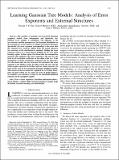Learning Gaussian Tree Models: Analysis of Error Exponents and Extremal Structures
Author(s)
Tan, Vincent Yan Fu; Anandkumar, Animashree; Willsky, Alan S.
DownloadTan-2010-Learning Gaussian Tree Models Analysis of Error Exponents and Extremal Structures.pdf (789.9Kb)
PUBLISHER_POLICY
Publisher Policy
Article is made available in accordance with the publisher's policy and may be subject to US copyright law. Please refer to the publisher's site for terms of use.
Terms of use
Metadata
Show full item recordAbstract
The problem of learning tree-structured Gaussian graphical models from independent and identically distributed (i.i.d.) samples is considered. The influence of the tree structure and the parameters of the Gaussian distribution on the learning rate as the number of samples increases is discussed. Specifically, the error exponent corresponding to the event that the estimated tree structure differs from the actual unknown tree structure of the distribution is analyzed. Finding the error exponent reduces to a least-squares problem in the very noisy learning regime. In this regime, it is shown that the extremal tree structure that minimizes the error exponent is the star for any fixed set of correlation coefficients on the edges of the tree. If the magnitudes of all the correlation coefficients are less than 0.63, it is also shown that the tree structure that maximizes the error exponent is the Markov chain. In other words, the star and the chain graphs represent the hardest and the easiest structures to learn in the class of tree-structured Gaussian graphical models. This result can also be intuitively explained by correlation decay: pairs of nodes which are far apart, in terms of graph distance, are unlikely to be mistaken as edges by the maximum-likelihood estimator in the asymptotic regime.
Date issued
2010-04Department
Massachusetts Institute of Technology. Department of Electrical Engineering and Computer Science; Massachusetts Institute of Technology. Laboratory for Information and Decision SystemsJournal
IEEE Transactions on Signal Processing
Publisher
Institute of Electrical and Electronics Engineers
Citation
Tan, V.Y.F., A. Anandkumar, and A.S. Willsky. “Learning Gaussian Tree Models: Analysis of Error Exponents and Extremal Structures.” Signal Processing, IEEE Transactions on 58.5 (2010): 2701-2714. © Copyright 20110 IEEE
Version: Final published version
Other identifiers
INSPEC Accession Number: 11228720
ISSN
1053-587X